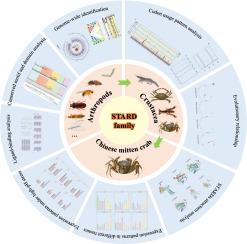节肢动物STARD家族的深入研究:全基因组鉴定、进化分析和表达模式
IF 2.2
2区 生物学
Q4 BIOCHEMISTRY & MOLECULAR BIOLOGY
Comparative Biochemistry and Physiology D-Genomics & Proteomics
Pub Date : 2025-08-11
DOI:10.1016/j.cbd.2025.101606
引用次数: 0
摘要
甾体急性调控域(STARD)蛋白家族在胆固醇和类胡萝卜素运输中起关键作用;然而,人们对它们在节肢动物中的进化历史、基因结构和潜在配体知之甚少。本研究对甲壳类动物中的STARD家族进行了全面的研究,重点研究了中华绒螯蟹的系统发育关系、进化动力学、配体偏好和表达模式。在34种代表性节肢动物中共鉴定出196个STARD基因,大多数节肢动物均表现出STARD1/3的选择性。它们被分成6个分支,每个分支都对8种类胡萝卜素表现出不同的亲和力。标准是进化保守的,它们在净化选择下倾向于相似的密码子。在中华按蚊中,鉴定出6个具有不同组织特异性表达模式的STARD基因。此外,肝胰脏中STARD3和STARD11的mRNA水平在高ph环境下显著上调,这可能反映了一种增强类胡萝卜素利用的适应性机制,从而减轻高ph胁迫造成的氧化损伤,维持肝胰脏稳态。总之,这些结果为了解节肢动物STARD家族的进化动态、配体偏好和功能多样化提供了有价值的见解,并突出了该基因家族在节肢动物中的未来研究方向。本文章由计算机程序翻译,如有差异,请以英文原文为准。

Insights into the STARD family in arthropods: Genome-wide identification, evolutionary analysis and expression patterns
Steroidogenic acute regulatory domain (STARD) protein family plays a crucial role in cholesterol and carotenoids transport; however, little is known about their evolution history, gene structure and potential ligands in arthropods. This study comprehensively investigated the STARD family in crustaceans, focusing on phylogenetic relationships, evolutionary dynamics, ligand preferences, and expression patterns in the Chinese mitten crab Eriocheir sinensis. In total, 196 STARD genes were identified across 34 representative arthropods, and the STARD1/3 alternative was exhibited in most arthropods. STARDs were grouped into six clades, each exhibiting distinct affinities for eight carotenoids. STARDs were evolutionarily conserved, they were under purifying selection with a preference for similar codons. In E. sinensis, six STARD genes were identified with distinct tissue-specific expression patterns. Moreover, the mRNA levels of STARD3 and STARD11 in the hepatopancreas were significantly upregulated upon high-pH exposure, likely reflecting an adaptive mechanism to enhance carotenoid utilization, thereby mitigating oxidative damage from high-pH stress and maintaining hepatopancreatic homeostasis. Overall, these results provide valuable insights into the evolutionary dynamics, ligand preferences and functional diversification of STARD family in arthropods, which highlights the future research direction of this gene family in arthropods.
求助全文
通过发布文献求助,成功后即可免费获取论文全文。
去求助
来源期刊
CiteScore
5.10
自引率
3.30%
发文量
69
审稿时长
33 days
期刊介绍:
Comparative Biochemistry & Physiology (CBP) publishes papers in comparative, environmental and evolutionary physiology.
Part D: Genomics and Proteomics (CBPD), focuses on “omics” approaches to physiology, including comparative and functional genomics, metagenomics, transcriptomics, proteomics, metabolomics, and lipidomics. Most studies employ “omics” and/or system biology to test specific hypotheses about molecular and biochemical mechanisms underlying physiological responses to the environment. We encourage papers that address fundamental questions in comparative physiology and biochemistry rather than studies with a focus that is purely technical, methodological or descriptive in nature.

 求助内容:
求助内容: 应助结果提醒方式:
应助结果提醒方式:


